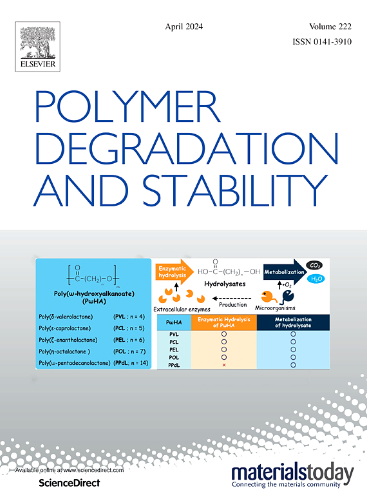A novel flame-retardant polyurethane coating with self-healing function by photothermal conversion
IF 6.3
2区 化学
Q1 POLYMER SCIENCE
引用次数: 0
Abstract
Polyurethane (PU) materials are widely utilized in the design of self-healing material systems. Due to their poor flame resistance and violent droplet behavior during combustion, challenges remain in achieving PU materials exhibiting self-healing, flame retardancy, and robust mechanical performance. Here, a self-healing flame-retardant composite coating (PU-3) was developed by incorporating PDA@EG, a filler prepared by coating expanded graphite (EG) with polydopamine (PDA), into a PU matrix featuring multiple hydrogen bonds and disulfide bonds. As a photothermal conversion agent, PDA@EG enables PU-3 to achieve rapid photothermal conversion (82.9 °C within 3 min), a toughness repair efficiency of 93.79 % under near-infrared (NIR) light for 10 min, and repeatable self-healing. Additionally, PDA@EG can also act as a flame retardant, mitigating the dripping behavior and increasing the limiting oxygen index (LOI). The essence is as a charring agent to form a completely expanded carbon layer after heating, preventing the exchange of O2 and heat. The synergistic interaction between PDA@EG and the hydrogen bond/disulfide bond matrix enables the combined self-healing and flame-retardant properties of PU-3. This work provides a heuristic perspective for the design of self-healing flame-retardant coating.
一种新型的具有自愈功能的光热转化聚氨酯阻燃涂料
聚氨酯(PU)材料广泛应用于自愈材料系统的设计。由于其较差的阻燃性和燃烧过程中剧烈的液滴行为,在实现PU材料具有自愈性,阻燃性和强大的机械性能方面仍然存在挑战。本研究将聚多巴胺(PDA)包覆膨胀石墨(EG)制备的填料PDA@EG掺入具有多个氢键和二硫键的PU基体中,制备了一种自修复阻燃复合涂层(PU-3)。作为光热转换剂,PDA@EG可使PU-3实现快速光热转换(3分钟内82.9°C),近红外(NIR)光下10分钟的韧性修复效率为93.79%,并可重复自愈。此外,PDA@EG还可以作为阻燃剂,减轻滴落行为,提高极限氧指数(LOI)。其本质是作为一种炭化剂,在加热后形成完全膨胀的碳层,防止O2和热量的交换。PDA@EG与氢键/二硫键基质之间的协同作用使PU-3具有自愈和阻燃的综合性能。本研究为自愈性阻燃涂料的设计提供了一个启发式的视角。
本文章由计算机程序翻译,如有差异,请以英文原文为准。
求助全文
约1分钟内获得全文
求助全文
来源期刊

Polymer Degradation and Stability
化学-高分子科学
CiteScore
10.10
自引率
10.20%
发文量
325
审稿时长
23 days
期刊介绍:
Polymer Degradation and Stability deals with the degradation reactions and their control which are a major preoccupation of practitioners of the many and diverse aspects of modern polymer technology.
Deteriorative reactions occur during processing, when polymers are subjected to heat, oxygen and mechanical stress, and during the useful life of the materials when oxygen and sunlight are the most important degradative agencies. In more specialised applications, degradation may be induced by high energy radiation, ozone, atmospheric pollutants, mechanical stress, biological action, hydrolysis and many other influences. The mechanisms of these reactions and stabilisation processes must be understood if the technology and application of polymers are to continue to advance. The reporting of investigations of this kind is therefore a major function of this journal.
However there are also new developments in polymer technology in which degradation processes find positive applications. For example, photodegradable plastics are now available, the recycling of polymeric products will become increasingly important, degradation and combustion studies are involved in the definition of the fire hazards which are associated with polymeric materials and the microelectronics industry is vitally dependent upon polymer degradation in the manufacture of its circuitry. Polymer properties may also be improved by processes like curing and grafting, the chemistry of which can be closely related to that which causes physical deterioration in other circumstances.
 求助内容:
求助内容: 应助结果提醒方式:
应助结果提醒方式:


